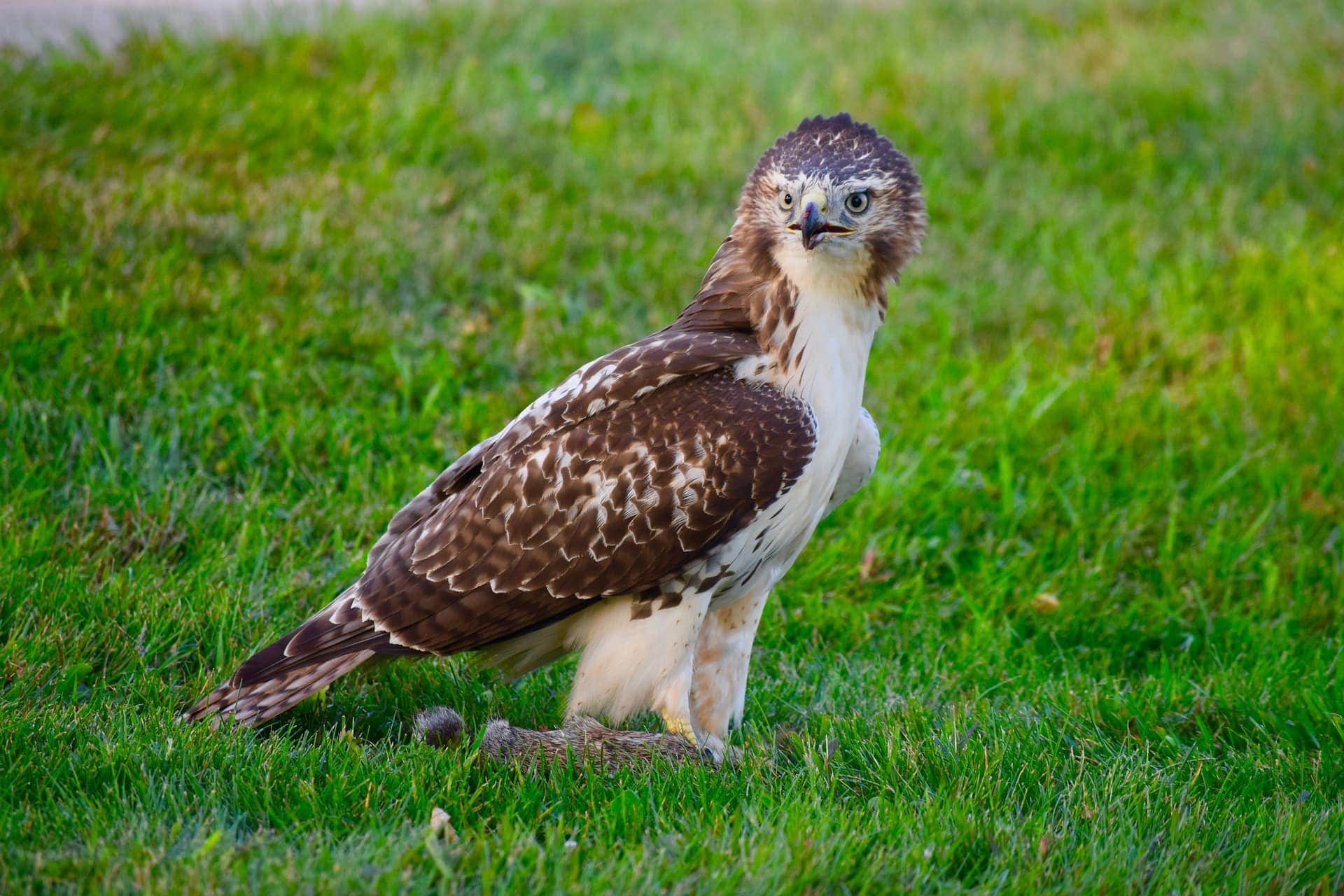Do Hawks Migrate? The Surprising Answer!
Last Updated on

Not all hawks migrate. Some, mainly southern species, do not. Most species are partial migrants, with northern species migrating relatively short distances within North America and southern populations remaining sedentary. Some migratory species currently live year-round in different cities.

How to Identify Different Hawk Species In The World
Hawks give many identification challenges. Some species have juvenile and adult feathers and sometimes dark to light looks.
Hawk identification usually starts with a general description of hawks as a group of large birds. All raptors are meat-eaters that prey on other birds, small mammals, reptiles, and the like in their territory.
The 7 Most Common Hawks & Their Migration Patterns
1. Sharp-Shinned Hawk

| Length: | 9 – 13.5 inches |
| Weight: | 3 – 8 oz |
| Wingspan: | 16.5 – 26.5 inches |
| Scientific Name: | Accipiter Striatus |
Sharp-shinned hawks are the smallest hawks and are highly athletic and acrobatic. It is common to see these birds dashing through the woods or by your bird feeders at a rapid speed.
To identify these raptors, check for orange bars on their upper chest that fades towards the underbody and blue-gray wings and back. When flying, their wings are relatively rounded and short but with a long tail. Females are larger than males.
Sharped-shinned hawks are commonly found in tree-covered areas. You can often see them around bird feeders, hunting and preying on the songbirds that come to visit. These hawks are pitfall predators who sit patiently and then dash out from their hiding area rapidly to chase birds, which they feed on.
These raptors are pretty similar to the Cooper’s hawk, and these two species can be confusing to birders. One of the best ways to differentiate them is by size. Sharp-shinned hawks are relatively smaller than Cooper’s.
On average, a sharp-shinned hawk is around 6 inches shorter and half the weight of the Cooper’s.
Another ideal way to identify a Sharp-shinned hawk is by listening to its sounds. These birds produce a high-pitched shrill “kik-kik-kik” which they often repeat several times.
2. Cooper’s Hawk

| Length: | 13.5 – 20 inches |
| Weight: | 8 – 24 oz |
| Wingspan: | 24.5 – 35.5 inches |
| Scientific Name: | Accipiter Cooperii |
You can often find these raptors in the woods or on the fields’ corners. Cooper’s hawks are known for their flying swiftness. Due to their incredible flying abilities, these hawks mainly feed on songbirds, and you can commonly see them in backyards around bird feeders.
A cooper’s hawk ideally appears similar to the sharp-shinned hawk. Their rigid blue-gray look is almost like that of a sharp-shinned hawk, absolute to the relatively black cover that both wear and the red-colored chest.
Cooper’s hawks usually emit an alarm call that sounds like “cak-cak-cak” or “kuck, kuck, kuck.” They produce a louder sound than a higher-pitched sharp-shinned hawk.
3. Red-Tailed Hawk

| Length: | 18 – 26 inches |
| Weight: | 1.5 – 3.5 oz |
| Wingspan: | 43 – 55 inches |
| Scientific Name: | Buteo Jamaicensis |
This species is the most common hawk and one that most people are familiar with.
You can often see these large hawks on long drives in the countryside, perched on a utility pole, or soaring in the sky. Red-tailed hawks feature white or virtually black plumage color, so the color may not be a reliable indicator. The ideal way to identify a red-tailed hawk is by looking for their typical red tail.
In most places, you will see more Red-tailed hawks during the winter than in the summer. They are birds that spend their summer in the north and migrate in the winter to join the year-round populations.
Red-tailed hawks are highly adaptable, and there is no definite description of their preferred habitats since they seem comfortable anywhere. Pick habitats, such as deserts, woodlands, pastures, scrublands, rainforests, or parks, and you will find them thriving.
Their common preys include rabbits, mice, rats, ground squirrels, and voles. However, you may also find them eating carrion, snakes, and larger birds.
Mating continuously, the favorite nesting areas for red-tailed hawks are tall trees that offer a perfect view of the surrounding land. These raptors will perch on window ledges or choose the highest point on a billboard in urban areas. They will often reuse nests from previous years, but they can build a nest in less than a week if a new one is needed.
4. Northern Goshawk

| Length: | 16 – 27 inches |
| Weight: | 22 – 50 oz |
| Wingspan: | 35 – 50 inches |
| Scientific Name: | Accipiter Gentilis |
Northern Goshawks are secretive birds that are difficult to see since they prefer living in huge forests away from refinement. You can mistakenly confuse them with Cooper’s hawk since they look kind of similar.
However, you can quickly identify a Norther Goshawk through their dark-colored head, usually paired with deep red eyes. Their underpart is often bluish-white or light gray with barring. Their upper part is blue-gray or brown with unique morphs.
Some Northern Goshawks are short-term migrants during colder seasons, moving south until they find adequate food. Other raptors remain in the same place year-round.
These birds are close relative to Sharp-shinned and Cooper’s hawks, but they are giant and wild. If you get too near to their nest, these defensive birds are likely to attack you.
Northern goshawks make a harsh “ca-ca-ca” sound, and as they make an alarm, they turn their head slowly from side to side, which produces the vocal effect of a biloquist
Northern Goshawks are opportunistic hunters that eat a wide range of food. These include birds, insects, reptiles, and mammals.
5. Red-Shouldered Hawk

| Length: | 15 – 19 inches |
| Weight: | 1.1 – 1.9 pounds |
| Wingspan: | 38 – 42 inches |
| Scientific Name: | Buteo Lineatus |
Red-shouldered hawks have a secure rufous chest that is distinctly marked, often white underwings and a deeply banded tail. In addition, they have red shoulders that are visible when perched.
Unlike their counterparts, the red-tailed hawks that own substantial open areas, red-shouldered hawks are mainly forest inhabitants. Woods with an open-top canopy are their favorite place since this additional space allows them to hunt more efficiently. In addition, you can commonly see these raptors in suburban areas where there is a mixture of houses and woodlands.
When it comes to food, these raptors mainly eat small mammals, although they will prey on lizards, amphibians, and snakes if available.
These raptors have a unique hunting style. When hunting, they drop onto their prey directly from above.
It is easy to notice a red-shouldered hawk even before you see one. Red-shouldered hawks produce a loud alarm that sounds like “kee-ahh,” which they usually repeat several times.
6. Swainson’s Hawk
https://www.instagram.com/p/CV3zAfKvxbS/
| Length: | 18 – 22 inches |
| Weight: | 24 – 48 oz |
| Wingspan: | 46 – 54 inches |
| Scientific Name: | Buteo Swainsoni |
Swainson’s hawks are a west raptor, and you can often see them soaring or perched on utility poles, trees in open areas, or fence posts.
These hawks migrate each April and spend their summers breeding and raising their young ones. Towards the end of August or the beginning of September, they start a long-distance journey again.
Swainson’s hawks usually create large vessels when migrating, joining with other species, including Turkey Vultures and Broad-winged hawks.
The swainson’s hawk call is a loud alarm that sounds like “kreeeeer” and often lasts 2–3 seconds.
7. Harris’s Hawk

| Length: | 18 – 24 inches |
| Weight: | 1.5 – 2.5 pounds |
| Wingspan: | 36–48 inches |
| Scientific Name: | Parabuteo Unicinctus |
Harris’s hawks are a beautiful raptor of the southwest. What is unique about these raptors is that they are highly social birds, and you can often find them together in groups with compound social hierarchies. Harris hawks don’t migrate.
These raptors usually hunt together with sophisticated collective hunting styles. Interestingly, when they catch prey, individual birds feed in order according to their level of supremacy, similar to a wolves’ pack.
If they are not hunting together, individual birds will feed on birds, rodents, or ground squirrels.
Harris’s hawks own territory and stick around all year. You are likely to find them in desert grasslands with numerous high perches, such as utility poles, trees, or boulders. Because they live in dry areas, it is a must to have a consistent water source.
These raptors can make an annoying sound alarm that is produced when surprised or a threat is close.

In Conclusion
As you’ve now learned, some hawks migrate, some don’t, and still others have a partial migration routine. Their migration patterns (or lack thereof) are species-specific. We hope you’ve enjoyed reading our breakdown, and feel free to leave a comment below.
Featured Image Credit: Pixabay
About the Author Robert Sparks
Robert’s obsession with all things optical started early in life, when his optician father would bring home prototypes for Robert to play with. Nowadays, Robert is dedicated to helping others find the right optics for their needs. His hobbies include astronomy, astrophysics, and model building. Originally from Newark, NJ, he resides in Santa Fe, New Mexico, where the nighttime skies are filled with glittering stars.
Related Articles:
How to Clean a Refractor Telescope: Step-by-Step Guide
How to Clean a Telescope Eyepiece: Step-by-Step Guide
How to Clean a Rifle Scope: 8 Expert Tips
Monocular vs Telescope: Differences Explained (With Pictures)
What Is a Monocular Used For? 8 Common Functions
How to Clean a Telescope Mirror: 8 Expert Tips
Brightfield vs Phase Contrast Microscopy: The Differences Explained
SkyCamHD Drone Review: Pros, Cons, FAQ, & Verdict
